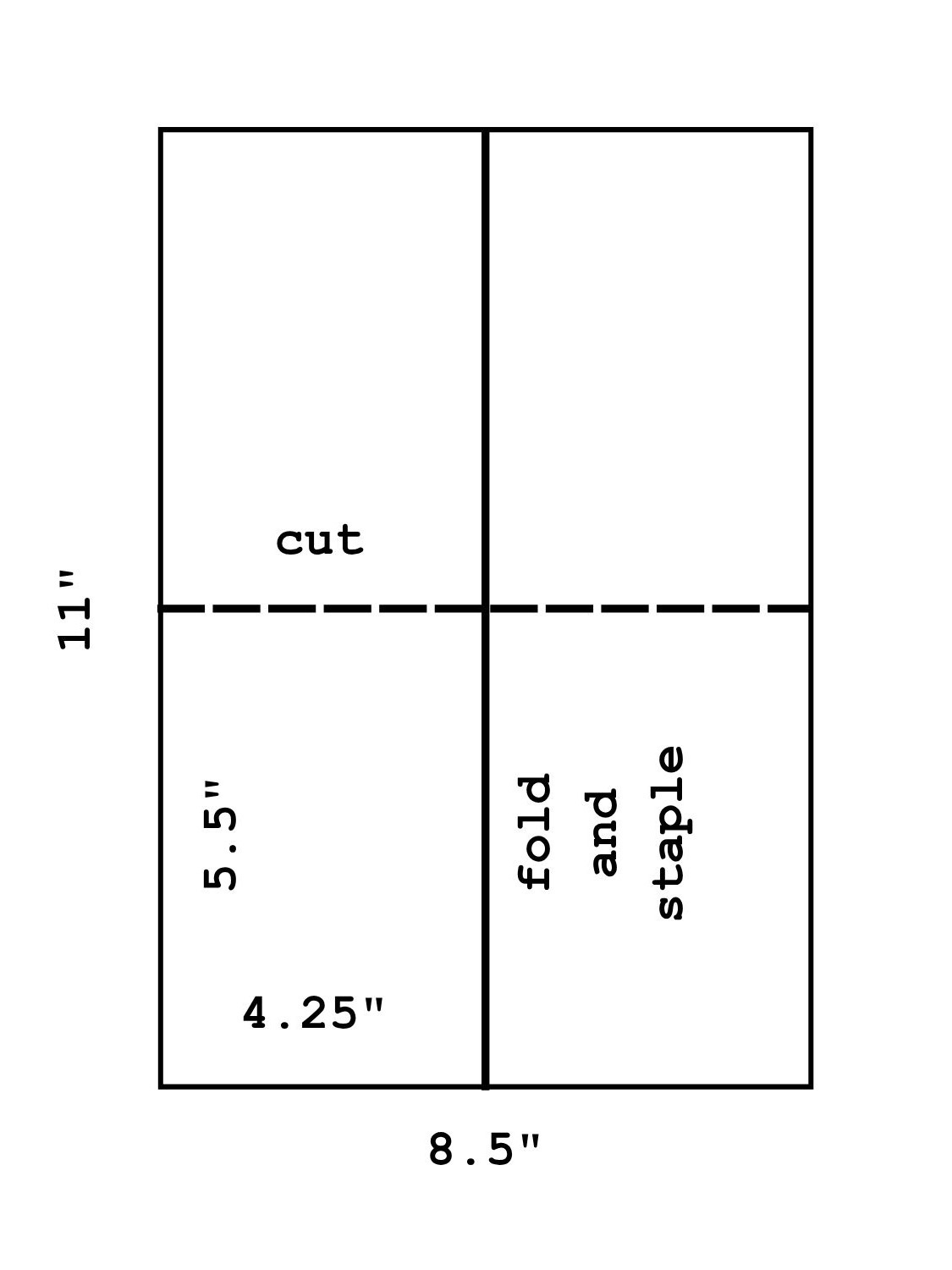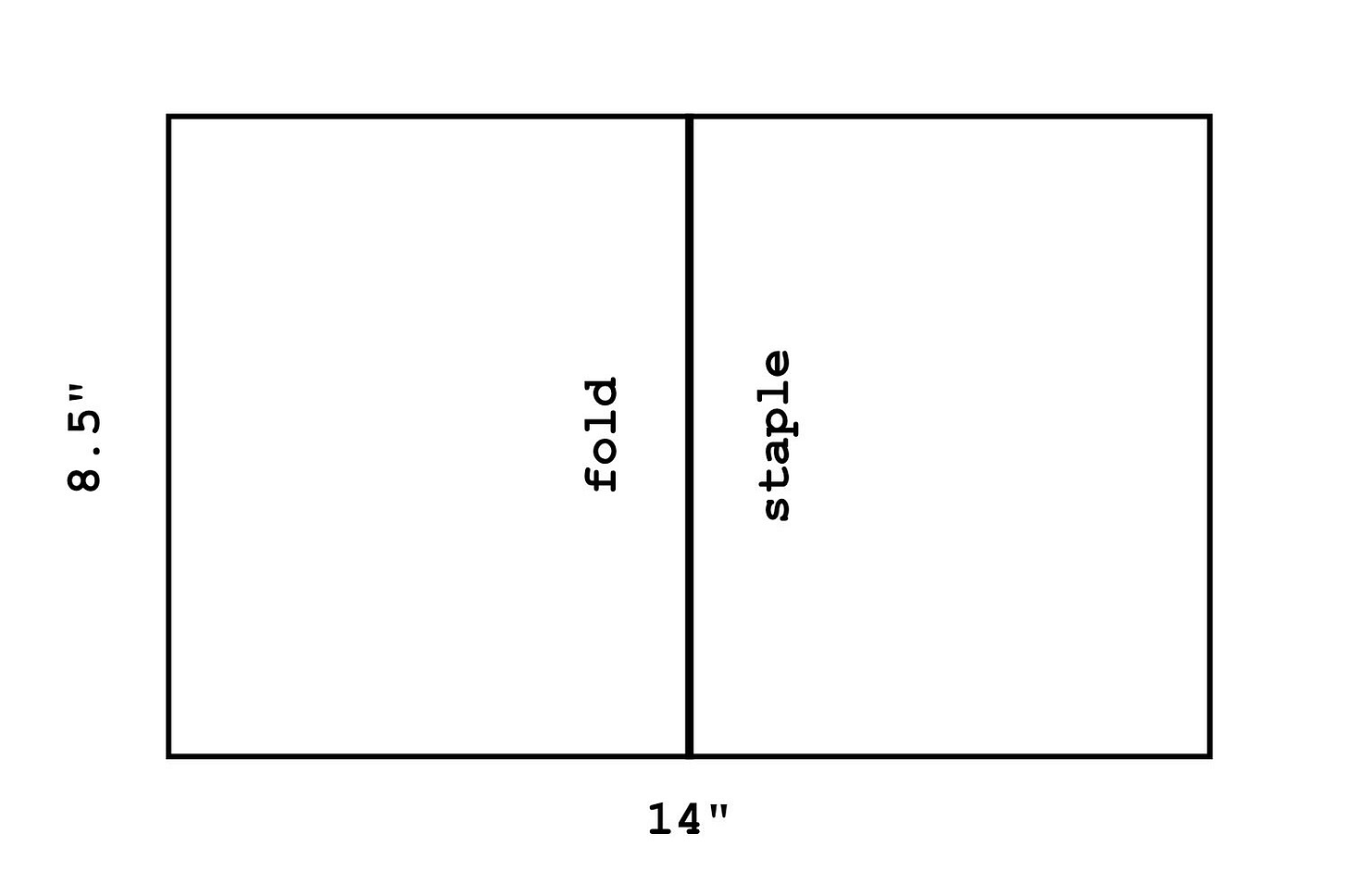This article appears in Issue 7 of Commonplace but thought it could also be a helpful resource. Please feel to use for educational purposes (attribution would be rad) like zine lessons or workshops. If you want to support my work you can find my zines here and restacks/comments/shares are always incredibly helpful. Thank you!
It was when I saw a post online asking if there were any other zine sizes aside from mini that I realized many new zinesters don’t know about all the different sizes of zines and what can be done with them. The mini zine - an 8 page size made from one side of a single sheet of 8.5” x 11” paper - is often taught in workshops and classrooms due to its ease of creation, and it’s non-threatening to new zinesters, requiring less than a paragraph worth of writing or several small illustrations to fill.
However, as one creates more zines, there may be a desire for more space, especially as thoughts expand or require more research, and that’s when it’s time to upgrade.
Note: You can absolutely start with a larger zine format! You are not obligated to start with mini zines even though that’s what a lot of people will suggest. Half page zines (using letter sized pieces of paper folded in half, stacked together at the fold, and stapled in the center) used to be the starter zine size in the 90s. Thinking you have to start making zines with the mini size is like saying you have to start writing poetry with haiku. There are a lot of zine sizes and formats, and many zinesters have a size that they specialize in. It’s about finding what’s right for you and what you create.
Below is a tour of multiple zine sizes/formats and what types of zines they work well for. They are in order from most to least accessible in terms of cost and availability of supplies. The ones at the top of the list you can easily make with supplies from a standard workplace, whereas the ones at the bottom require a significant investment of money or time to develop an additional skill.
Half Size Zines
Half size zines or half letter size zines are made from sheets of letter-sized paper, held with the longest side horizontal (landscape orientation), and folded in half. These sheets are stacked and stapled in the center to create the zine. This was considered the “standard” size for zines for a long time. Four pages can fit onto one sheet of paper with each page being 8.5” tall x 5.5” wide. Around 72 pages (18 sheets of paper) it gets hard to staple. At that point you can upgrade to an industrial stapler, but I would suggest perfect binding for zines this large (see below). Almost always, half size zines use at least two pieces of paper. Less than that, a quarter size zine (see next) might be a better option. Art zines printed in this format often use heavier weight paper, especially color zines (see professional printing, below).
Half size zines are a great catch-all for zine creation. They work well for essay zines, fanzines, perzines, zines with interviews, longer-format poetry, art zines; anything you can think of.
Quarter Size Zines
Quarter size zines are also made with a sheet of letter-sized paper. Held vertically (portrait orientation), they are cut in half horizontally, then those two pieces are folded in half vertically and stacked together. This size was traditionally used for Mini Comix. Eight pages can fit on one sheet of paper with each page being 5.5” tall and 4.25” wide. Zines can have however many pages you can staple together, but quarter size zines are generally on the shorter size. When they are only 8 pages (one sheet) they can also be printed on cardstock for more durability. Standard weight paper is recommend if using more than one sheet.
Quarter size zines are good for smaller illustrations and work well as art and poetry zines. They can also be fun for very focused topics or super short essays.
Half Legal
Half legal size zines have been around for a long time, but one has to have access to legal sized paper (8.5” tall x 14” wide) as well as a printer that can handle it, and this is becoming increasingly less common. Half legal size zines are folded in the same was as half letter (a paper folding book I had described it as a “hamburger fold” which should give you an idea), leaving a page that is 8.5” tall and 7” wide. Like the previous sizes, these zines are stapled in the center, but they require a long arm stapler (I have seen people simply not stample half legal zines, please don’t do this, staple your zines, people!) and always use multiple pieces of paper.
While half legal size zines have been around a long time they are less common now because of the slightly less accessible materials (special paper, copier, special stapler) and because of the increased shipping size and cost. However, they are great for zines that are in a “magazine style” with multiple articles and large illustrations, as well as for comic zines. Layer a good number of pages together and they start to feel like something quite substantial. This is an especially great format if there is a community or group that creates a zine on a regular basis; everyone has plenty of room to get their ideas out.

Non-Standard Sizes/Folds/Bindings
If you want to get creative with your zine making you can make ones that use non-standard in terms of sizes, bindings, or folding techniques. Zines that unfold like accordions, zines masquerading as pamphlets, origami/puzzle purse zines, super tiny zines, zines with hand-sewn binding, the sky is the limit. Many non-standard zine sizes are hard to reproduce or assemble, so they are usually small editions. However, this type of zine is perfect if you have a specific vision in mind or want to make something that is artisan with a focus on aesthetics or process rather than primarily conveying words and ideas.

Perfect Bound & Professionally Printed Zines
Professionally printed zines may sound like a bit of an oxymoron. Zines are, at their core, underground publications that are written and produced by individuals. However, the rise of affordable professional printing options has made things like full color printing and perfect binding way more accessible. If Riso zines - which require highly specialized equipment and often high costs - are zines, then professionally printed zines are zines, too. You might hear some zinesters say that professionally printed zines aren’t zines anymore, but I think that’s up to the individual.
Professional printing is great for zines that are full color, especially art zines (collage, photography, digital illustration, etc.) allowing you to share your art with people in in physical print. I use and recommend Mixam and their site will give you an idea of the cost, which starts at $2.50 per zine.
Riso Zines
Riso zines use a riso printer (notorious for expensive ink and high cost of maintenance) to create absolutely gorgeous zines. There are some people who collect riso zines exclusively and there are the current darling of the zine world. I put them almost at the bottom of the list because of their accessibility, both in terms of cost (around twice the price of professional printing, if not more) and the need to have files set up in a specific way. A great breakdown of the cost of riso zines can be found on Caroyln Yoo’s Substack. All that aside, riso zines are just so darn pretty.
They are really great for digital artists who already have the skill set needed to set up the files but generally are best for any zine that heavily uses illustration. You can print a riso zine that’s all text, but I’ve never seen it done.

Ergodic/Artisan
Ergodic literature is a type of writing that requires extra work from the reader to experience. One example that comes immediately to mind is House of Leaves that has text in spirals, tiny squares, or what tumbles off the page entirely. An example that I can think of for children are the Choose Your Own Adventure books from the 90s.
Ergodic or artisan zines are zines that take a lot of extra effort both to create and digest. Think stacks of various sized and color paper, tiny paper windows that open, pop up elements, anything that engages the reader physically with the zine in a non-standard way. Artisan zines can have hand-colored illustrations or original drawings and collages. For example, an illustration zine in addition of five where every page is an original. Think of artisan zines as non-standard zines on steroids. They are absolute labors of love.
Making an artisan zine is something you do because you have a specific vision and you love it. These zines are rarely sold because they would be prohibitively expensive, but are given as gifts or created as a passion project.
So there you have it! Seven types of zines beyond the mini size format. I hope you enjoyed reading this and are feeling inspired to explore zine making a bit further. If you have any types of zines to add to the list, I would love to hear about it and do share this breakdown with someone you love, hate, or feel nothing toward whatsoever in order to spread the zine knowledge.





I'm happy to have found you! Creating a zine is part of my Substack plan. It's lovely to read your articles and get a little inspiration. Thank you!
Thank you I feel inspired to try and make one 🙏